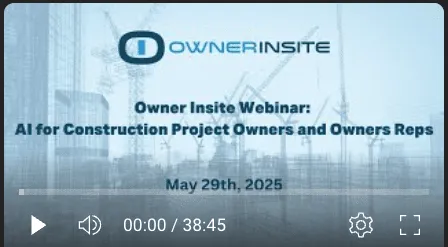Communication Matters: The True Value of Construction Project Documentation
If you are involved in managing construction projects but are not a construction professional, you may have already noticed how much paperwork even a relatively small job can generate. This underscores the importance of effective project communication and the need to connect it to your project documentation.
Every detail must be documented, discussed, and carefully considered before any progress can be made. You might sometimes feel overwhelmed by the amount of communication or wish that people would move forward with the work.
However, communication in construction projects is one of the most critical components of success. It can often determine the outcome of a project, so it’s vital to approach it in the way that is customary in the industry. Here’s some additional information on why effective communication is essential and how you can stay informed without being inundated with irrelevant information.
Time Really Is Money in the Construction World
It’s an ancient saying, but it does apply in the construction world. Material costs can fluctuate, and a few increases or changes might occur throughout a construction project.
However, delays, standing time, or slow progress can increase costs dramatically because every man-hour needs to be accounted for somehow.
Once a construction project starts to go off the rails and deviate from the project plan, it doesn’t take long for time and cost overruns to get out of control.
Everything Is Time Sensitive
Whether it’s a change order, an RFI, or an ITP hold point, everything on a construction site is time sensitive. Most construction contracts even have time limits during which certain notifications and claims need to be sent to be legally binding.
This is good news when everything is going well because it means your project team and contractors are on track. However, when someone drops the ball and misses a deadline, it can quickly escalate into a very serious problem.
If It's Not On Paper, It Didn't Happen
Every construction project is governed by a set of project documents. These include everything from pre-planning and feasibility studies to bid documents, drawing sets, change orders or notifications of intent, and even close-out documentation, all form part of the contract document.
But construction project documents are a living thing. They change and evolve, and all those changes must be recorded. This means that even once everyone on the project team moves on, there’s still a single source of truth that anyone can refer to.
It’s also why, in the construction world, if it’s not on paper, it didn’t.
How to Get the Information You Need
All of this sounds great so far, but there’s one problem if you’re not a construction professional on the project team: you probably don’t want to filter through mountains of documents and written instructions just to find the things that matter to you.
Much of the construction project communication generated between contractors, architects, or engineers are technical and irrelevant if you’re not involved in a hands-on capacity. That’s why many procurement officials and clients leave things up to their project team. There’s too much stuff to work through to find the critical information.
The good news is that there are a few ways you can ensure you have the construction project documentation you need and aren’t buried by the rest. Owner Insite was created to solve this issue for Owners.
Be Clear About Your Needs and Goals
Most architects and engineers who have worked on large construction projects are used to sharing construction project documentation with clients and property owners, but everyone has different reporting needs.
- Discuss your construction project communication needs with your professional team to establish guidelines about which information you need and when. Install language in your contracts that specify the official communication or record software platform.
- Determine which contract meetings you will attend, if any, or how you will receive updates from those meetings with your Owner Rep or PM.
- Set notification levels when your team needs to notify you of delays or cost increases – you might not need to know if the project is behind by a day or if the cost increases by 1%, but you probably have a comfort threshold for time and cost overruns. Leverage a cost overrun calculator.
Use Project Management Tools That Is Built for Owners
The problem with most construction project management tools is that they’re not built for people who aren’t fluent in the language of construction. Additionally, most of the project management software out there is built more for a specific role, such as the contractor or architect, and not the entire project team. They’re a maze of abbreviations, revisions, and versions of documents. Gantt charts, BIM, and many of the other tools your project team uses to track progress and productivity require training to use – or even understand.
The solution might be to use a tool like Owner Insite, which is designed to collect, analyze and present key project data that matters. The platform is collaborative and allows you to capture and, more importantly, retain all the information in perpetuity.
Correctly implemented, a tool like Owner Insite takes the information from your project team and allows you to easily understand items about time, cost, and other key metrics. So, you’re always up to date on the things that matter most.
Ban Email?
Even if you don’t use a purpose-built tool like Owner Insite, one of the most important things you can’t afford to do is to keep track of construction project documentation using email to share critical information. Gmail or Outlook should not be your official record of all communication.
Most of us face an avalanche of email messages every day. Some are moved to the junk folder by our spam filters. Others are clicked but never addressed or processed correctly, and others might accidentally be deleted.
Email is simply too porous to be a reliable method of construction project communication. So, like telephone conversations, it should always be followed up with a more controlled construction project documentation option.
Never Be Afraid to Ask
Finally, whether you use Owner Insite to simplify your construction project documentation and metrics or choose another method, if something doesn’t seem to make sense, don’t be afraid to ask.
Most project teams are very good at identifying problems and delays, but there’s always a chance that they might have missed something. Being proactive and asking about things that concern you is a great way to help your project team and, ultimately, your project success, not to mention your bottom line.




